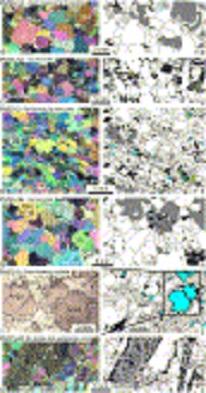Claudia Zaffarana. Andréa Tommasi. Alain Vauchez. Michel Grégoir
2 014
http://www.sciencedirect.com/science/article/pii/S0040195114001176
The subcontinental lithospheric mantle evolves through time due to tectonic events and processes as static recrystallization and melt percolation. To constrain the extent of these processes in the South Patagonian subcontinental mantle lithosphere we performed a microstructural and Electron Backscattered Diffraction (EBSD) study of a suite of 35 peridotite xenoliths brought to the surface by Plio-Pleistocene alkaline volcanic rocks from Gobernador Gregores and Pali Aike. All samples show a well-developed olivine and pyroxene crystallographic preferred orientation (CPO), consistent with deformation by dislocation creep with dominant activation of [100]{0kl} in olivine. The coarse granular or tabular textures and the low density of intracrystalline deformation features indicate that deformation was followed by annealing under static conditions. The xenoliths also show microstructural evidence of multiple episodes of reactive melt percolation. Neither annealing nor melt percolation erased the olivine CPO, which has [010]-fiber, [100]-fiber and orthorhombic patterns in Pali Aike xenoliths and essentially [010]-fiber and orthorhombic patterns in Gobernador Gregores xenoliths. Seismic properties calculated based on the CPO and modal compositions are, however, rather homogeneous, with fast S-wave polarization and P-wave propagation parallel to the [100] olivine axis. The variation in the olivine CPO solely changes the minimum S-wave birefringence direction, which is normal to the foliation for axial-[010] olivine CPO. Average samples for the two localities, obtained by adding up the individual samples CPO data in a common reference frame, show, however, a ‘normal’ upper mantle anisotropy with a maximum S-wave birrenfringence of ca. 5% at high angle to the both the maximum [010] and [100] axes concentrations, that is in the foliation, but normal to the lineation, and a minimum birefringence at low angle to the [100] maximum, that is parallel to the lineation.
http://www.sciencedirect.com/science/article/pii/S0040195114001176

